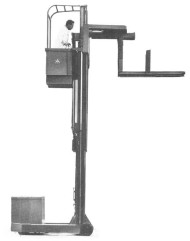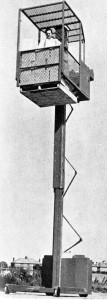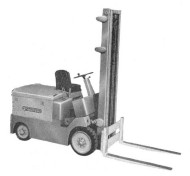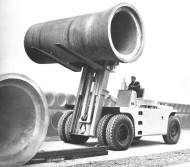 Warehouse & Logistics News is proud to bring you the fortysecond instalment in our exclusive series on the history of the fork lift truck, the machine that over the decades has revolutionised the face of materials handling around the world.
Warehouse & Logistics News is proud to bring you the fortysecond instalment in our exclusive series on the history of the fork lift truck, the machine that over the decades has revolutionised the face of materials handling around the world.
Our writer is James Brindley, an acknowledged authority on fork lift trucks. James’s distinguished career has involved engineering and management roles with BT Rolatruc and serving as a Director of the Fork Lift Truck Association, before he set up the National Fork Truck Heritage Centre in 2004 as Britain’s first such collection open to the public.
The Heritage Centre continues to need your support in 2009, and if you or your company would like to help in any way, you can contact James on the number below. Now sit back and enjoy the latest part of this fascinating series.
Episode 42: 1964: Lansing Bagnall innovates in narrow aisle sector
 1964 was the year of the Ninth Mechanical Handling Exhibition at Earls Court London, and most manufacturers were eager to show off their new products.
1964 was the year of the Ninth Mechanical Handling Exhibition at Earls Court London, and most manufacturers were eager to show off their new products.
One company in particular who found the wait until May particularly long was Lansing Bagnall, with two narrow aisle machines designed to elevate the operator with the load. The first of these was the model FAES1; known as the turret truck, it had a fork unit that could rotate through an arc of 180 degrees and reach into the racking to extract or replenish a pallet load of goods. This operation was in the total control of the operator who, whilst travelling at the same height as the fork unit, was able to move pallets on either side of the aisle. Travelling at the same height as the forks also enabled a more precise operation and less damage to the goods and racking. Because it was the load and not the truck that turned on its axis, Lansing Bagnall claimed his machine saved 50 percent of the aisle width required by a standard reach truck. This being so, it was further claimed that it was also possible to double the capacity of the store.
Lansing Bagnall’s other new narrow aisle machine allowed the operator to order pick at heights in excess of 12 feet.
Known as the FSES4 it was possible to pick up a pallet at ground level and select goods from pallets stored at any height and from both sides of the racking. The pallet was enclosed with safety guards, as was the entrance to the pallet area from the driving position. This entrance was in the form of a safety gate interlock and as such was a physical barrier to the main driving controls when the operator was loading the truck pallet.
 New trucks were also released in March 1964 by Stacatruc Ltd with their 4524E Mark III and 524E Mark III Stacatruc electric forklift trucks. Improvements from the old models included increasing the wheelbase to make the steering easier, and new motors and pumps to increase the lift speeds. To give better performance and smoother controls, a modified series-parallel electrical system was utilised. This arrangement gave the machine four speeds in both forward and reverse and incorporated a battery-tapping arrangement. This was applied to the first speed in both directions, as only this part of the circuitry was routed through a resistance. To prevent the same half of the battery being run down when a considerable amount of low speed work was involved, a battery selection relay used each half alternately each time the accelerator was depressed.
New trucks were also released in March 1964 by Stacatruc Ltd with their 4524E Mark III and 524E Mark III Stacatruc electric forklift trucks. Improvements from the old models included increasing the wheelbase to make the steering easier, and new motors and pumps to increase the lift speeds. To give better performance and smoother controls, a modified series-parallel electrical system was utilised. This arrangement gave the machine four speeds in both forward and reverse and incorporated a battery-tapping arrangement. This was applied to the first speed in both directions, as only this part of the circuitry was routed through a resistance. To prevent the same half of the battery being run down when a considerable amount of low speed work was involved, a battery selection relay used each half alternately each time the accelerator was depressed.
 In April, one month before the Earls Court exhibition, Boss (Engineers) Ltd introduced their new “D” series heavy-duty lift trucks. They were built in four lift capacities: D30, 30,000 lbs at 48 inch load centre, D40, 40,000 lbs at 48 inch load centre, D45, 45,000 lbs at 42 inch load centre and D45, 45,000 lbs at 48 inch load centre. All machines were fitted with the Leyland Power Plus 680 diesel, rated at 200bhp at 2,000rpm and giving a maximum torque of 550 lb ft at 1,300rpm. A fully automatic, single-stage torque converter, mounted integrally with the engine, was coupled with the four speed power-shift gearbox. This arrangement gave the truck an unladen top speed of 30mph and a top speed of 25mph fully loaded in forward or reverse. There were seven choices of lift heights between 8 ft and 24 ft and the mast’s single lift chain, said to be the largest of its type made, consisted of 8 x 8 combination (links per section) x 2 inch pitch. The trucks dimensions were 346 inches overall length and 113 inches overall width, together with an overall height of 85 inches to the top of the engine cover.
In April, one month before the Earls Court exhibition, Boss (Engineers) Ltd introduced their new “D” series heavy-duty lift trucks. They were built in four lift capacities: D30, 30,000 lbs at 48 inch load centre, D40, 40,000 lbs at 48 inch load centre, D45, 45,000 lbs at 42 inch load centre and D45, 45,000 lbs at 48 inch load centre. All machines were fitted with the Leyland Power Plus 680 diesel, rated at 200bhp at 2,000rpm and giving a maximum torque of 550 lb ft at 1,300rpm. A fully automatic, single-stage torque converter, mounted integrally with the engine, was coupled with the four speed power-shift gearbox. This arrangement gave the truck an unladen top speed of 30mph and a top speed of 25mph fully loaded in forward or reverse. There were seven choices of lift heights between 8 ft and 24 ft and the mast’s single lift chain, said to be the largest of its type made, consisted of 8 x 8 combination (links per section) x 2 inch pitch. The trucks dimensions were 346 inches overall length and 113 inches overall width, together with an overall height of 85 inches to the top of the engine cover.
To be continued
By James Brindley, Director, National Fork Truck Heritage Centre
If you would like to support the National Fork Truck Heritage Centre, please call James Brindley on 0780 195 4167




Comments are closed.